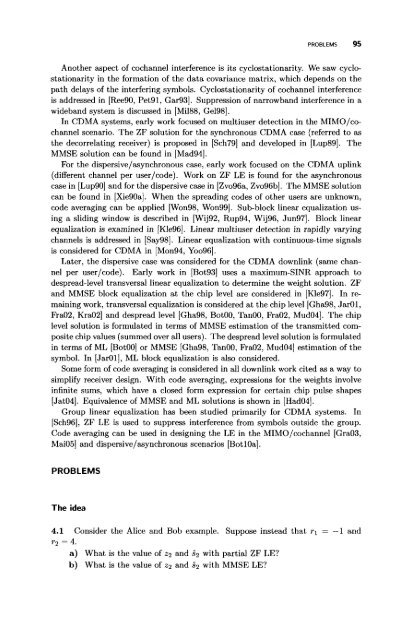mohatta2015.pdf
signal processing from power amplifier operation control point of view
signal processing from power amplifier operation control point of view
You also want an ePaper? Increase the reach of your titles
YUMPU automatically turns print PDFs into web optimized ePapers that Google loves.
PROBLEMS 95<br />
Another aspect of cochannel interference is its cyclostationarity. We saw cyclostationarity<br />
in the formation of the data covariance matrix, which depends on the<br />
path delays of the interfering symbols. Cyclostationarity of cochannel interference<br />
is addressed in [Ree90, Pet91, Gar93]. Suppression of narrowband interference in a<br />
wideband system is discussed in [Mil88, Gel98].<br />
In CDMA systems, early work focused on multiuser detection in the MIMO/cochannel<br />
scenario. The ZF solution for the synchronous CDMA case (referred to as<br />
the decorrelating receiver) is proposed in [Sch79] and developed in [Lup89]. The<br />
MMSE solution can be found in [Mad94].<br />
For the dispersive/asynchronous case, early work focused on the CDMA uplink<br />
(different channel per user/code). Work on ZF LE is found for the asynchronous<br />
case in [Lup90] and for the dispersive case in [Zvo96a, Zvo96b]. The MMSE solution<br />
can be found in [Xie90a]. When the spreading codes of other users are unknown,<br />
code averaging can be applied [Won98, Won99]. Sub-block linear equalization using<br />
a sliding window is described in [Wij92, Rup94, Wij96, Jun97]. Block linear<br />
equalization is examined in [Kle96]. Linear multiuser detection in rapidly varying<br />
channels is addressed in [Say98]. Linear equalization with continuous-time signals<br />
is considered for CDMA in [Mon94, Yoo96].<br />
Later, the dispersive case was considered for the CDMA downlink (same channel<br />
per user/code). Early work in [Bot93] uses a maximum-SINR approach to<br />
despread-level transversal linear equalization to determine the weight solution. ZF<br />
and MMSE block equalization at the chip level are considered in [Kle97]. In remaining<br />
work, transversal equalization is considered at the chip level [Gha98, JarOl,<br />
Fra02, Kra02] and despread level [Gha98, BotOO, TanOO, Fra02, Mud04]. The chip<br />
level solution is formulated in terms of MMSE estimation of the transmitted composite<br />
chip values (summed over all users). The despread level solution is formulated<br />
in terms of ML [BotOO] or MMSE [Gha98, TanOO, Fra02, Mud04] estimation of the<br />
symbol. In [JarOl], ML block equalization is also considered.<br />
Some form of code averaging is considered in all downlink work cited as a way to<br />
simplify receiver design. With code averaging, expressions for the weights involve<br />
infinite sums, which have a closed form expression for certain chip pulse shapes<br />
[Jat04]. Equivalence of MMSE and ML solutions is shown in [Had04].<br />
Group linear equalization has been studied primarily for CDMA systems. In<br />
[Sch96], ZF LE is used to suppress interference from symbols outside the group.<br />
Code averaging can be used in designing the LE in the MIMO/cochannel [Gra03,<br />
Mai05] and dispersive/asynchronous scenarios [BotlOa].<br />
PROBLEMS<br />
The idea<br />
4.1 Consider the Alice and Bob example. Suppose instead that n = — 1 and<br />
r 2 = 4.<br />
a) What is the value of zi and s



